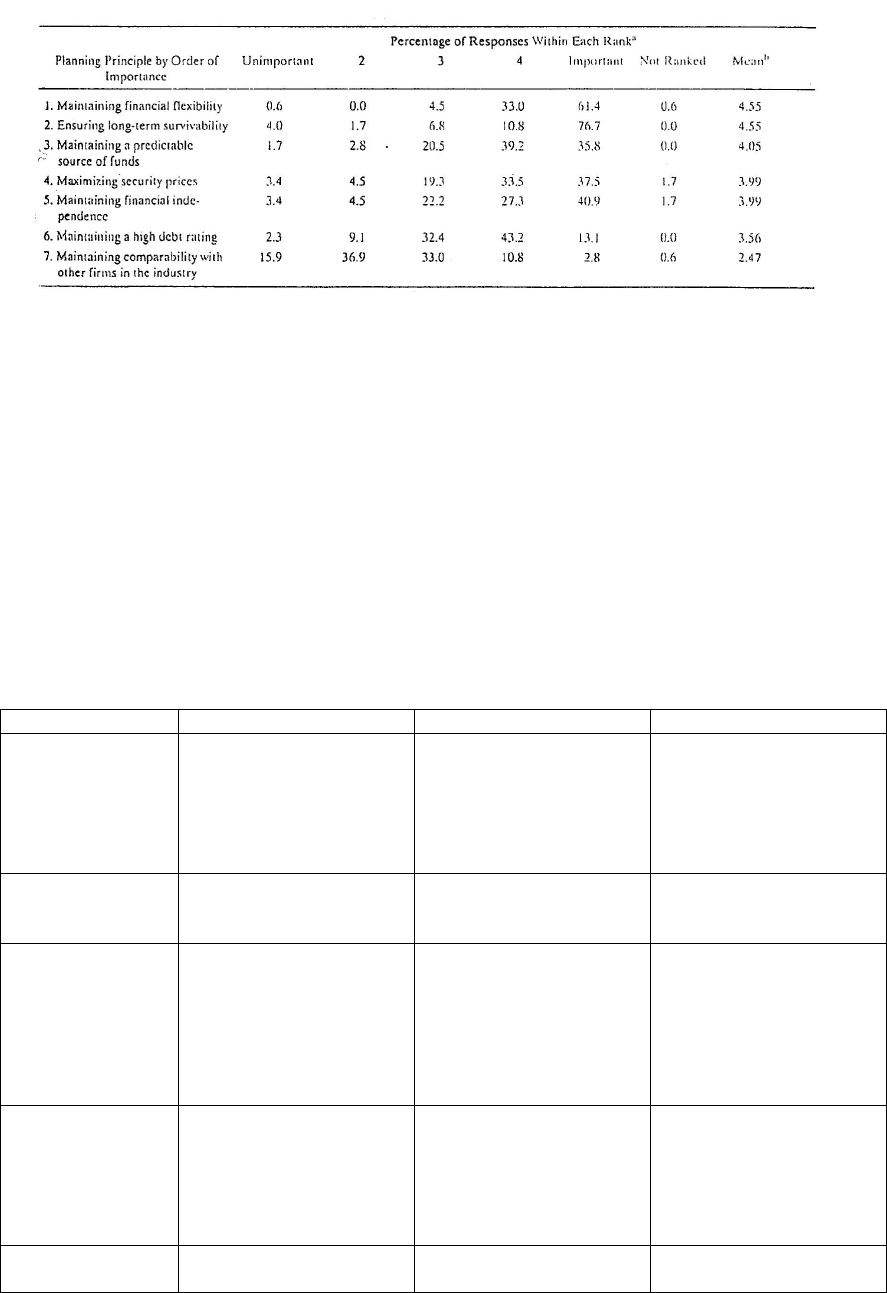Damodaran A. Applied corporate finance
Подождите немного. Документ загружается.


48
48
The Probability of Bankruptcy
The probability of bankruptcy is the likelihood that a firm’s cash flows will be
insufficient to meet its promised debt obligations (interest or principal). While such a
failure does not automatically imply bankruptcy, it does trigger default, with all its
negative consequences. Using this definition, the probability of bankruptcy is a function
of the following –
(1) Size of operating cash flows relative to size of cash flows on debt obligations: Other
things remaining equal, the larger the operating cash flows relative to the cash flows on
debt obligations, the smaller the likelihood of bankruptcy. Accordingly, the probability of
bankruptcy increases marginally for all firms, as they borrow more money, irrespective of
how large and stable their cash flows might be.
(b) Variance in Operating Cash Flows: Given the same cash flows on debt, a firm with
completely stable and predictable cash flows has a lower probability of bankruptcy than
does another firm with a similar level of operating cash flows, but with far greater
variability in these cash flows.
The Cost of Bankruptcy
The cost of going bankrupt is neither obvious nor easily quantified. It is true that
bankruptcy is a disaster for all involved in the firm –– lenders often get a fraction of what
they are owed, and equity investors get nothing –– but the overall cost of bankruptcy
includes the indirect costs on operations of being perceived as having high default risk.
a. Direct Costs
The direct, or deadweight, cost of bankruptcy is that which is incurred in terms of
cash outflows at the time of bankruptcy. These costs include the legal and administrative
costs of a bankruptcy, as well as the present value effects of delays in paying out the cash
flows. Warner (1977) estimated the legal and administrative costs of 11 railroads to be,
on average, 5.3% of the value of the assets at the time of the bankruptcy. He also
estimated that it took, on average, 13 years before the railroads were reorganized and
released from the bankruptcy costs. These costs, while certaintly not negligible, are not
overwhelming, especially in light of two additional factors. First, the direct cost as a
percentage of the value of the assets decreases to 1.4% if the asset value is computed five

49
49
years before the bankruptcy. Second, railroads, in general, are likely to have higher
bankruptcy costs than other companies, because of the nature of their assets (real estate
and fixed equipment).
b. Indirect Costs
If the only costs of bankruptcy were the direct costs noted above, the low leverage
maintained by many firms would be puzzling. There are, however, much larger costs
associated with taking on debt and increasing default risk, which arise prior to the
bankruptcy, largely as a consequence of the perception that a firm is in financial trouble.
The first is the perception on the part of the customers of the firm that the firm is in
trouble. When this happens, customers may stop buying the product or service, because
of the fear that the company will go out of business. In 1980, for example, when car
buyers believed that Chrysler was on the verge of bankruptcy, they chose to buy from
Ford, GM, and other car manufacturers, largely because they were concerned about
receiving service and parts for their cars after their purchases. Similarly, in the late 1980s,
when Continental Airlines found itself in financial trouble, business travelers switched to
other airlines because they were unsure about whether they would be able to accumulate
and use their frequent flier miles on the airline. The second indirect cost is the stricter
terms suppliers start demanding to protect themselves against the possibility of default,
leading to an increase in working capital and a decrease in cash flows. The third cost is
the difficulty the firmmay experience trying to raise fresh capital for its projects –– both
debt and equity investors are reluctant to take the risk, leading to capital rationing
constraints, and the rejection of good projects.
Shapiro and Titman point out that the indirect costs of bankruptcy are likely to be
higher for the following types of firms:
• Firms that sell durable products with long lives that require replacement parts and
service: Thus, a personal computer manufacturer would have higher indirect costs
associated with bankruptcy than would a grocery store.
• Firms that provide goods or services for which quality is an important attribute but is
difficult to determine in advance: Since the quality cannot be determined easily in
advance, the reputation of the firm plays a significant role in whether the customer

50
50
will buy the product in the first place. For instance, the perception that an airline is in
financial trouble may scare away customers who worry that the planes belonging to
the airline will not be maintained in good condition.
• Firms producing products whose value to customers depends on the services and
complementary products supplied by independent companies: Returning to the
example of personal computers, a computer system is valuable only insofar as there is
software available to run it. If the firm manufacturing the computers is perceived to
be in trouble, it is entirely possible that the independent suppliers that produce the
software might stop providing it. Thus, if Apple Computers gets into financial
trouble, many software manufacturers might stop producing software for its
computers, leading to an erosion in its potential market.
• Firms that sell products that require continuous service and support from the
manufacturer: A manufacturer of copying machines for which constant service seems
to be a necessary operating characteristic, would be affected more adversely by the
perception of default risk than would a furniture manufacturer, for example.
Implications for Optimal Capital Structure
If the expected bankruptcy cost is indeed the product of the probability of
bankruptcy and the direct and indirect bankruptcy cost, interesting and testable
implications emerge for capital structure decisions –
• Firms operating in businesses with volatile earnings and cash flows should use debt
less than should otherwise similar firms with stable cash flows. For instance,
regulated utilities in the United States have high leverage because the regulation and
the monopolistic nature of their businesses result in stable earnings and cash flows. At
the other extreme, toy manufacturing firms such as Mattel can have large shifts in
income from one year to another, based upon the commercial success or failure of a
single toy
15
; These firms should use leverage far less in meeting their funding needs.
• If firms can structure their debt in such a way that the cash flows on the debt increase
and decrease with their operating cash flows, they can afford to borrow more. This is
15
In years past, a single group of toys such as the Teenage Mutant Ninja turtles or the Power Rangers,
could account for a substantial proportion of a major toy manufacturer’s profits.

51
51
because the probability of default is greatest when operating cash flows decrease, and
the concurrent reduction in debt cash flows makes the default risk lower. Commodity
companies, whose operating cash flows increase and decrease with commodity prices,
may be able to use more debt if the debt payments are linked to commodity prices.
Similarly, a company whose operating cash flows increase as interest rates (and
inflation) go up and decrease when interest rates go down may be able to use more
debt if the debt has a floating rate feature.
• If an external entity provides protection against bankruptcy, by providing either
insurance or bail outs, firms will tend to borrow more. To illustrate, the deposit
insurance offered by the FSLIC and the FDIC enables savings & loans and banks to
maintain higher leverage than they otherwise could. While one can argue for this
insurance on the grounds of preserving the integrity of the financial system, under
charging for the insurance will accentuate this tendency and induce high risk firms to
take on too much debt, letting taxpayers bear the cost. Similarly, governments that
step in and regularly bail out firms on social grounds (e.g., to save jobs) will
encourage all firms to overuse debt.
• Since the direct bankruptcy costs are higher, when the assets of the firm are not easily
divisible and marketable, firms with assets that can be easily divided and sold should
be able to borrow more than firms with assets that do not share these features. Thus, a
firm, such as Weyerhauser, whose value comes from its real estate holdings should be
able to borrow more money than a firm such as Coca Cola, which derives a great deal
of its value from its brand name.
• Firms that produce products that require long-term servicing and support generally
have lower leverage than firms whose products do not share this feature, as we
discussed above.
7.13. ☞: Debt and Bankruptcy
Rank the following companies on the magnitude of bankruptcy costs from most to least,
taking into account both explicit and implicit costs:
a. A Grocery Store
b. An Airplane Manufacturer

52
52
c. High Technology company
Explain.
There is a data set on the web that summarizes, by sector, variances in operating
earnings.
2. Debt creates agency costs
Equity investors, who receive a residual claim on the cash flows, tend to favor
actions that increase the value of their holdings, even if that means increasing the risk that
the bondholders (who have a fixed claim on the cash flows) will not receive their
promised payments. Bondholders, on the other hand, want to preserve and increase the
security of their claims. Since the equity investors generally control the firm’s
management and decision making, their interests will dominate bondholder interests
unless bondholders take some protective action. By borrowing money, a firm exposes
itself to this conflict and its negative consequences and it pays the price in terms of both
higher interest rates and a loss of freedom in decision making.
The conflict between bondholder and stockholder interests appears in all three aspects
of corporate finance: (1) deciding what projects to take (making investment decisions),
(2) choosing how to finance these projects and (3) determining how much to pay out as
dividends:
Risky projects: In the section on investment
analysis, we argued that a project that earn a return
that exceed the hurdle rate, adjusted to reflect the
risk of the project, should be accepted and will
increase firm value. The caveat, though, is that
bondholders may be hurt if the firm accepts some of these projects. Bondholders lend
money to the firm with the expectation that the projects accepted will have a certain
risk level, and they set the interest rate on the bonds accordingly. If the firm chooses
projects that are riskier than expected, however, bondholders will lose on their
Risk Shifting: Risk shifting refers
to the tendency of stockholders in
firms and their agents (managers) to
take on much riskier projects than
bondholders expect them to.
53
53
existing holdings because the price of the holdings will decrease to reflect the higher
risk.
Subsequent Financing: The conflict between stockholder and bondholder interests
also arises when new projects have to be financed. The equity investors in a firm may
favor new debt, using the assets of the firm as security and giving the new lenders
prior claims over existing lenders. Such actions will reduce the interest rate on the
new debt. The existing lenders in a firm, obviously do not want to give new lenders
priority over their claims, because it makes the existing debt riskier (and less
valuable). A firm may adopt a conservative financial policy and borrow money at
low rates, with the expectation of keeping its default risk low. Once it has borrowed
the money, however, the firm might choose to shift to a strategy of higher debt and
default risk, leaving the original lenders worse off.
Dividends and Stock Repurchases: Dividend payments and equity repurchases also
divide stockholders and bond holders. Consider a firm that has built up a large cash
reserve but has very few good projects available. The stockholders in this firm may
benefit if the cash is paid out as a dividend or used to repurchase stock. The
bondholders, on the other hand, will prefer that the firm retain the cash, since it can
be used to make payments on the debt, reducing default risk. It should come as no
surprise that stockholders, if not constrained, will pay the dividends or buy back
stock, overriding bondholder concerns. In some cases, the payments are large and can
increase the default risk of the firm dramatically.
The potential for disagreement between stockholders and bondholders can show
up in as real costs in two ways:
a. If bondholders believe there is a significant chance that stockholder actions might
make them worse off, they can build this expectation into bond prices by demanding
much higher interest rates on debt.
b. If bondholders can protect themselves against such actions by writing in restrictive
covenants, two costs follow –
• the direct cost of monitoring the covenants, which increases as the covenants
become more detailed and restrictive.

54
54
• the indirect cost of lost investments, since the firm is not able to take certain
projects, use certain types of financing, or change its payout; this cost will also
increase as the covenants becomes more restrictive.
As firms borrow more and more and expose themselves to greater agency costs, these
costs will also increase.
Since agency costs can be substantial, two implications relating to optimal capital
structure follow. First, the agency cost arising from risk shifting is likely to be greatest in
firms whose investments cannot be easily observed and monitored. For example, a lender
to a firm that invests in real estate is less exposed to agency cost than is a lender to a firm
that invests in people or intangible assets. Consequently, it is not surprising that
manufacturing companies and railroads, which invest in substantial real assets, have
much higher debt ratios than service companies. Second, the agency cost associated with
monitoring actions and second-guessing investment decisions is likely to be largest for
firms whose projects are long term, follow unpredictable paths, and may take years to
come to fruition. Pharmaceutical companies in the United States, for example, which
often take on research projects that may take years to yield commercial products, have
historically maintained low debt ratios, even though their cash flows would support more
debt.
7.14. ☞: Risk Shifting and Bondholders
It is often argued that bondholders who plan to hold their bonds until maturity and collect
the coupons and the face value are not affected by risk shifting that occurs after they buy
the bonds, since the effect is only on market value. Do you agree?
a. Yes
b. No
Explain.

55
55
3. Using up excess debt capacity reduces financial flexibility
As noted earlier, one of the by-products of the
conflict between stockholders and bondholders is the
introduction of strict bond covenants that reduce the
flexibility of firms to make investment, financing, or
dividend decisions. It can be argued that this is part of a
much greater loss of flexibility arising from taking on
debt. One of the reasons firms do not use their debt
capacity is that they like to preserve it for a rainy day,
when they might need the debt to meet funding needs or
specific contingencies. Firms that borrow to capacity lose
this flexibility and have no fallback funding if they do get into trouble.
Firms value financial flexibility for two reasons. First, the value of the firm may
be maximized by preserving some flexibility to take on future projects, as they arise.
Second, flexibility provides managers with more breathing room and more power, and it
protects them from the monitoring that comes with debt. Thus, while the argument for
maintaining flexibility in the interests of the firm is based upon sound principles, it is
sometimes used as camouflage by managers pursuing their own interests. There is also a
trade-off between not maintaining enough flexibility (because a firm has too much debt)
and having too much flexibility (by not borrowing enough).
So, how best can we value financial flexibility? If flexibility is needed to allow
firms to take advantage of unforeseen investment opportunities, its value should
ultimately be derived from two variables. The first is access to capital markets. After all,
firms that have unlimited access to capital markets will not need to maintain excess debt
capacity since they can raise funds as needed for new investments. Smaller firms and
firms in emerging markets, on the other hand, should value financial flexibility more. The
second is the potential for excess returns on new investments. If a firm operates in a
mature business where new investments, unpredictable though they might be, earn the
cost of capital, there is no value to maintaining flexibility. Alternatively, a firm that
operates in a volatile business with high excess returns should attach a much higher value
to financial flexibility.
Financial Flexibility: Financial
flexibility refers to the capacity
of firms to meet any unforeseen
contingencies that may arise
(such as recessions and sales
downturns) and take advantage
of unanticipated opportunities
(such as great projects), using
the funds they have on hand and
any excess debt capacity that
they might have nurtured.

56
56
7.15. ☞: Value of Flexibility and Firm Characteristics
Both Ford and Microsoft have huge cash balances (as a percent of firm value), and you
are a stockholder in both firms. The management of both firms claim to hold the cash
because they need the flexibility. Which of the two managements are you more likely to
accept this argument from?
a. Microsoft’s management
b. Ford’s management
Explain.
The Trade-off in a Balance Sheet Format
Bringing together the benefits and the costs of debt, we can present the trade off
in a balance sheet format in table 7.3:
Table 7.3: Trade off on Debt versus Equity
Advantages of Borrowing
Disadvantages of Borrowing
1. Tax Benefit:
Higher tax rates --> Higher tax benefit
1. Bankruptcy Cost:
Higher business risk --> Higher Cost
2. Added Discipline:
Greater the separation between managers
and stockholders --> Greater the benefit
2. Agency Cost:
Greater the separation between stock-
holders and lenders --> Higher Cost
3. Loss of Future Financing Flexibility:
Greater the uncertainty about future
financing needs --> Higher Cost
Overall, if the marginal benefits of borrowing exceed the marginal costs, the firm should
borrow money. Otherwise, it should use equity.
What do firms consider when they make capital structure decisions? To answer
this question, Pinegar and Wilbricht surveyed financial managers at 176 firms in the
United States. They concluded that the financial principles listed in Table 7.4 determine
capital structure decisions, in the order of importance in which they were given.
Table 7.4: Financial Principles Determining Capital Structure Decisions

57
57
The foremost principles the survey participants identified were maintaining financial
flexibility and ensuring long term survivability (which can be construed as avoiding
bankruptcy). Surprisingly few managers attached much importance to maintaining
comparability with other firms in their industries or maintaining a high debt rating.
Illustration 7.4: Evaluating the Debt Trade off – Disney, Aracruz and Bookscape
In table 7.5, we summarize our views on the potential benefits and costs to using
debt, instead of equity, at Disney, Aracruz and Bookscape.
Table 7.5: The Debt Equity Trade Off: Disney, Aracruz and Bookscape
Item
Disney
Aracruz
Bookscape
Tax Benefits
Significant. The firm has a
marginal tax rate of 35%.
It does have large
depreciation tax shields.
Significant. The firm has a
marginal tax rate of 34%,
as well. It does not have
very much in non-interest
tax shields.
Significant. The owners of
Bookscape face a 40% tax
rate. By borrowing
money, the income that
flows through to the
investor can be reduced.
Added Discipline
Benefits will be high,
since managers are not
large stockholders.
Benefits are smaller, since
the voting shares are
closely held by insiders.
Benefits are non-existent.
This is a private firm.
Bankruptcy Cost
Movie and broadcasting
businesses have volatile
earnings. Direct costs of
bankruptcy are likely to be
small, but indirect costs
can be significant.
Variability in paper prices
makes probability of
bankruptcy high. Direct
and indirect costs of
bankruptcy likely to be
moderate.
Costs may be small but
the owner has all of his
wealth invested in the
firm. Since his liability, in
the event of failure, is not
limited, the costs will
viewed as very large.
Agency Costs
High. While theme park
assets are tangible and
fairly liquid, is is much
more difficult to monitor
movie and broadcasting
businesses.
Low. Assets are tangible
and liquid.
Low. Prime asset is
leasehold, which is liquid.
Flexibility Needs
Low in theme park
business but high in media
Low. Business is mature
and investment needs are
Low. Book store is
established and additional
